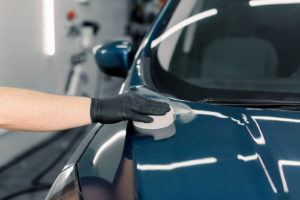How to Choose the Best Car Wax
July 2nd, 2020 by Fix Auto USA

Car wax has evolved a great deal since 1800, which was originally developed to protect the paint on horse carriages. Two hundred and twenty years have since passed, but the goal is probably not all that different. Still today, protecting your car and maintaining the good looks for as long as possible is what it’s all about.
With all the choices on the market, selecting the best car wax for your car is no easy feat. We will break it all down for you in this blog, so you’ll have all the information you need to choose the best car wax.
Why wax a car?
Some people ask, “Why wax a car? Is it really that important?” Yes, it really is that important. If you care about your car. Waxing helps protect the paint from oxidation and other environmental elements and keeps it looking young and beautiful.
Protect
A wax compound adds a layer of protection to the paint and protects it from environmental damage, everything from tree sap and bird droppings to moisture, the sun’s UV rays, and paint oxidation, which causes your car’s shine to fade.
Beautify
Why wax a car? Because it can bring out its color and make its finish more vibrant. It can also cover up imperfections, scratches, and corrosion.
What is car wax made of?
Car wax is traditionally made from a combination of waxes (e.g., carnauba and bee wax), oils, ethanol, mineral spirits, and solvents. Newer concoctions include special polymers and resins.
Increasingly, health-conscious and environmentally aware consumers are asking, “What is car wax made of?” States are passing laws that restrict the amount of harmful chemicals, such as volatile organic compounds (VOCs), that some car wax and polish may contain. If you see a car wax brand that says it is VOC compliant, it means it was manufactured according to the state standards and should, presumably, be safer for you and your vehicle.
If you’re in the market for car wax, you need to know the different types of car wax so you can select the best car wax for your needs.
Different types of car wax
Waxes are broken down into Cleaning and Finishing waxes.
Cleaner waxes
Cleaner waxes are also known as One-Step products or All-In-One products. If your car is older and your paint is not in good condition, you will want to go with a Cleaner wax because it contains powerful cleaning agents, which will help restore the condition of your paint.
Finishing waxes
A finishing wax will not do anything to clean your paint; it is intended for cars that are newer or have paint that is in tip-top condition. Finishing waxes are applied after the car paint has been cleaned and is in sparkling, near-pristine condition. A finishing wax is an ultimate protective layer for a car’s paint and is intended to maximize beauty, which is why it’s often used on showroom cars.
Different types of car wax can also be defined by their ingredients. What is car wax made of? One type is made up of natural ingredients, and the other is chemical-based.
1. Natural car wax
Natural car wax is made up of natural ingredients, typically from a base of carnauba wax, vegetable wax, or beeswax. Carnauba wax, which comes from trees that grow in South America, is combined with oils and petroleum distillates, producing one of the most popular natural waxes among car lovers.
It tends to give cars an extremely glossy shine!
Carnauba wax usually comes in either yellow or white, and you will find an array of carnauba-based products on the market. Because of its purity, the yellow variety is more expensive. Carnauba-based wax is great for all types of cars, but is known to be particularly effective at restoring the luster and shine of dark-colored vehicles.
The only negative is that you will have to re-wax your car quite frequently – three to five times a year – as its shine diminishes faster than chemical-based, synthetic wax products.
2. Synthetic Car Wax
Synthetic waxes are composed of powerful chemicals that are great for removing dirt and grime from your vehicle. They can protect your car and give it an awesome shine that, depending on the weather conditions where you live, can last for a whole year.
Synthetic car waxes are ideal for drivers who want a fast-working, low-maintenance, and relatively inexpensive product that they can use once a year.
On the other hand, while synthetic car waxes may produce a longer-lasting shine, it is generally not as vibrant and deep as you’re going to get with a natural, carnauba-based car wax product. If you have a dark-colored car and want it to have a rich, vibrant luster, you might be better off using a natural car wax.
There are not only different types of car wax, but there are also different forms.
Different Forms of Car Wax
Choose the form of car wax that is appropriate for your car: liquid, paste, or spray.
1. Liquid wax
Liquid wax is probably the most popular wax among everyday drivers because its smooth finish lasts a long time. It has good cleaning power and should give your car a nice gloss.
What are the disadvantages? Some brands of liquid wax tend to be abrasive and could damage your car’s exterior. Also, some drivers say it can be difficult to apply evenly since it dries fast.
2. Paste wax
Most natural car wax products are usually a paste. They are an easy to apply wax that gives your car a beautiful, glossy shine, a nice smell, and better protection than spray waxes and liquid waxes.
If you use a paste wax, the disadvantages are that you have to use it more frequently, because the shine wears off more quickly than liquid wax, and it generally costs more than liquid or spray wax.
3. Spray Wax
The spray function makes it easy to apply the wax accurately and thoroughly. Besides being convenient, a spray wax can provide a high shine and is usually not abrasive. If you have a two-years or newer car and already has a nice finish, a spray wax could be a good choice.
On the downside, it is not a great cleaner, and the shine doesn’t last long, so you will probably be doing frequent retouching. The good news is that the spray function makes it easy to add more as needed.
Best car wax
As you can see, there are many different types of car wax. What is the best car wax? It depends on your car’s specific needs and how much time you want to invest in waxing your car.
If you are pressed for time and eager to get it over with, a synthetic option might be the best car wax for you. They tend to be easier to apply, and you should be able to complete your vehicle in a half hour. Some people enjoy being outside and spending the afternoon attending to their car. If you are in no hurry and enjoy waxing, then a paste wax may be the best car wax for you.
Also, take the age of your car into consideration. If you value ease of use and convenience, try a spray wax, especially if you have a newer car. But keep in mind that it will require frequent applications if you want to maintain the shine.
If your car is older and has a lackluster paint job, the best car wax for you might be a liquid wax, because it contains powerful cleaning agents that could help restore the luster to your finish.
Whether your vehicle is light-colored or has a darker hue can also help determine the best car wax for you. Waxes, especially chemical-based varieties, can be abrasive and leave swirl marks or tiny scratches on your car’s finish.
Darker colored cars, in particular, are prone to having their paint finish damaged by car waxes that tend to be more abrasive, such as spray waxes. An abrasive wax could leave a clear-coated surface with a duller look than it had prior to waxing. Read the car wax packaging before purchase to make sure it is suitable for clear coat finishes.
Say you have a lot of plastic on your car, around the door and bumper. Then the best car wax might be one that does better with plastic, such as a spray wax.
Why wax a car? Waxing your car, which should occur after polishing it, is the best way to protect your car’s paint. That said, nothing beats washing your car regularly – that alone is the most effective way to protect your car’s paint.
What a layer of wax does is give your paint additional protection against environmental factors, including pollutants, oxidation, and the heat.
Remember, caring for your car is a long-term commitment. Even the best car wax tends to last no more than a few months, and some waxes start to wear off after only a month. So, plan to repeat the process every few months, four or five times a year.
That’s not a lot to ask, considering everything your car does for you, day in and day out.
This blog post was contributed by Fix Auto Ontario, a leading industry expert and collision repair shop servicing customers in Ontario, a city located in southwestern San Bernardino County in California.
Welcome to
Fix Auto USA
We are the premier independent body shop network delivering world-class customer service and high-quality collision repairs across the U.S.
Learn About Us





